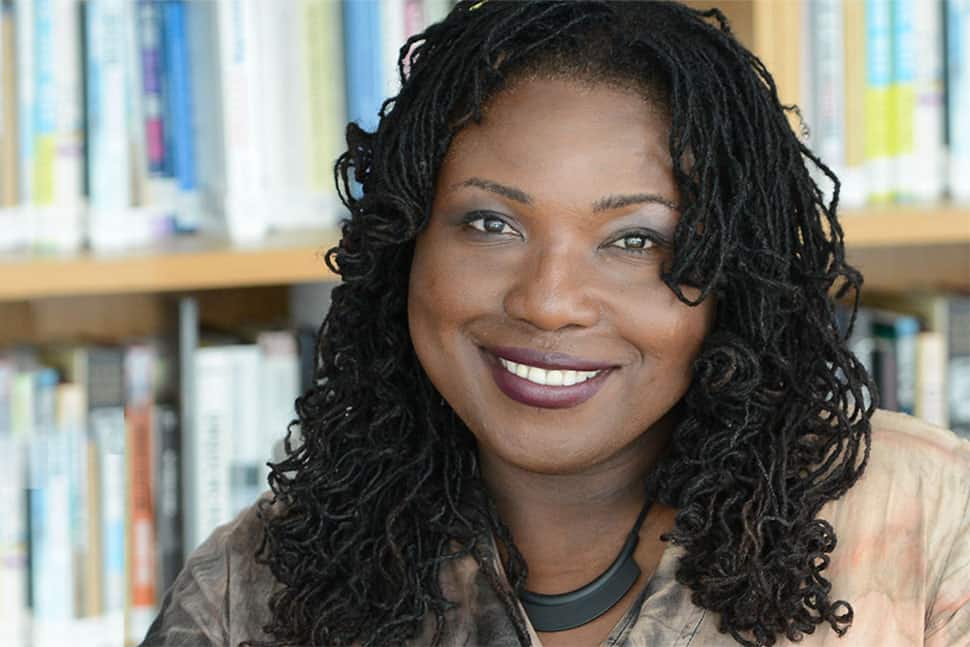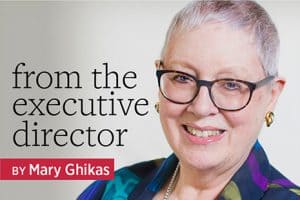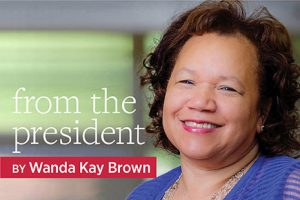
Tracie D. Hall will begin on February 24 as the American Library Association’s new executive director, the 10th executive director—and the first female African-American executive director—in ALA’s 143-year history. In her role, Hall will oversee the oldest and largest library association in the world, made up of 57,000 members and more than 200 staffers.
Hall comes to the Association from the Chicago-based Joyce Foundation and has worked at Seattle Public Library, the New Haven (Conn.) Free Public Library, Hartford (Conn.) Public Library, and Queens (N.Y.) Public Library. She also previously worked at ALA in the early 2000s as director of the Office for Diversity.
She received her MLIS from the Information School at University of Washington in Seattle and holds a master’s in international and area studies with an emphasis on sub-Saharan Africa from Yale University. She also has dual bachelor’s degrees in law and society and black studies from the University of California, Santa Barbara.
Hall answered questions from American Libraries to introduce herself to ALA members and staff.
What’s your earliest memory of a library?
My earliest memories are of going to the library with my grandmother. She didn’t drive, so we’d walk very slow, taking in everything along the way until we got to the Watts branch of the Los Angeles Public Library. The building was a kind of yellow. Later, when I grew up, I would understand it to be quite small. But to me as a young child, it felt huge and like church. The books seemed to emanate a certain energy that made the space feel special and monumental.
What originally drew you to the library field?
Two things, really. We had an amazing black studies librarian, Sylvia Curtis, when I was an undergraduate at UC Santa Barbara. She was an early model for me of the librarian as activist and intellectual, which later in my studies would be exemplified by the work of Arturo Schomburg, A. P. Marshall, E. J. Josey, and Kathleen de la Peña McCook. But at that initial stage of career exploration, Sylvia left an indelible impression. She was dedicated to our growth as scholars and researchers. I practically lived in our university library because of that.
After graduate school in my mid-20s, I found myself managing a youth homeless shelter in Los Angeles and was again drawn to the work and stance of librarians. I’d make it my business to take our youth residents to the library. I wanted them to take advantage of all the free materials and resources. Many institutions stigmatize homeless people. The librarians I met, though, seemed progressive, empathetic, and eager to help. I took note of that. When budget shortfalls meant the shelter needed to shut down, I saw an advertisement for a job at Seattle Public Library that split time between youth outreach and reference services. I remember circling it and writing “dream job.” Four or five months later, there I was. Four years later I’d complete my MLIS.
What changes have you seen in the field since you joined it?
Obviously, the technology we have access to is exponentially more robust than when I entered the field. Some of the digital platforms we have today, we couldn’t have dreamed of. The technological advances have made libraries even more durable than when I arrived. It’s the opportunity to create and immediately disseminate content that excites me most and that I consider most consequential. The ability to connect, archive, and link learning communities around the hyper-generation and discovery of knowledge is what I believe necessitates contemporary library work and will keep the profession and libraries as institutions around as long as there are societies.
What do you wish more librarians knew?
That’s a trick question! Librarians know so much. It’s in the job description.
Let me start first with what I wish more people knew about librarians. There is still a large public that thinks that librarians read all day. Reading widely and critically is foundational and necessary to effective readers’ advisory. An important part of our work is to remain current with the evolution of the written record, but that’s just a baseline. The work that makes librarianship unique is that it is also our charge to order, curate, and preserve information and to broaden its accessibility and utility—and mitigate barriers that would limit its audience. Even having outlined all of that, I’m just getting started in identifying all the things librarians do.
So, to the original question, I wish that librarians truly knew how much the ubiquitous access to timely, reliable, and organized information that we take for granted in this country relies on their work as individual contributors and collectives. Understanding that also means knowing how important it is to effectively advocate for the unduplicated work of the profession. That’s an imperative. Thankfully that’s also the mission of the American Library Association.
Every profession has a blind spot or at least a weakness. What’s ours?
Maybe that as technology has progressed, we haven’t recognized that so much of our work has morphed and moved well beyond traditional library settings. As my career has evolved, I have met so many people working in tech companies with metadata and front-end development, and in governmental, for-profit, and nonprofit institutions working on platform accessibility or knowledge management. In many cases, these people are not trained in library or information science, but the issues they face are centered in these disciplines, particularly informatics. Our blind spot is perhaps being a bit late to making connections between our statements of work and bringing these knowledge workers into our folds. This is something we must change.
What lessons will you bring from your previous job?
The Joyce Foundation places a lot of emphasis on what we call “looking around the corner,” which means that we are expected to design programs and implement strategies that address emergent issues and also create long-term impact. Joyce is a 70-year-old foundation that in recent years has focused on racial equity and economic mobility for the next generation of Great Lakes residents. It does this work through the vehicles of culture, democracy, education and economic mobility, environment, and gun violence prevention and justice reform—all major systems and concerns. Being at Joyce has deepened my rigor around making evidence-informed decisions, both research and field-based, and sharpened my resolve to ensure that every significant investment touches both people and policy. I think this orientation will serve me well at ALA.
What are your trepidations about your new role?
I don’t have any. Fear is a natural reaction to new and uncertain circumstances. However, to dwell in or lead with fear or trepidation is a misdirection of energy.
Leadership is always a vulnerable position. That’s something I understand and will have to absorb. But I’m not walking into the door with fear. I’m walking in with a sense of mission, a desire to continue to propel the profession forward and to serve those who rely on it, and with a real belief that the preservation of our democracy relies on our ability to advocate for equitable information access. Will I have to make hard decisions? Yes. Will all of them be equally popular? I hope so, but that’s unlikely. Yet, I can honestly say that in my assessment, the opportunities that await the field and the Association at this time far outweigh the threats.
What will your priorities be in the first 100 days? First six months? A year?
There’s so much that demands attention. One of the Association priorities that really stands out is to expand our membership and stakeholder base. ALA is either the fifth or sixth largest trade association in the country, but our membership and partnerships reflect only a fraction of those engaged in or stewarding the work of library and information services. Reaching a broader base is key. I want those committed to universal literacy; to closing the school achievement gap or the wealth gap; to ending mass incarceration; to diversity, equity, accessibility, and inclusion; to environmental and community sustainability; and more, to see the Association as among the premier leaders and partners in that work. Getting there must begin with listening, observing, and assessing the needs and opportunities. That’s how I’ll spend my first 100 days. The next six months and beyond will be about working with Association leadership and staff on planning and implementation—and being sure we are inserting joy and discovery into the mix. My overriding goal as ALA’s new executive director is to take the Association to new and necessary levels. I want to create as much of an environment of levity and learning as I can. It is in that kind of setting that we often experience our greatest breakthroughs.
An executive director has a rare vantage point for spotting patterns concerning management, leadership, and human behavior. What do you expect to find at ALA?
More than anything I expect to find an admirable work ethic. To me, the commitment to serving the needs of its constituency is what defines ALA. I experienced that as a member, years before I came to work there.
I also expect to find a desire to wrangle with the biggest social issues of our time as they relate to information access and the positive social impact it creates. ALA staff and membership have demonstrated that they aren’t averse to risk-taking in that regard. ALA has been at the vanguard of insisting on intellectual freedom as a human right. Its investment in pipelines to increase racial and ethnic diversity and next-generation leadership in librarianship have galvanized the field and become models for other associations. ALA has also been at the forefront of advocating for library materials and services that reflect the range of sexual and gender orientation, and ensuring equitable library access to new immigrants, people with disabilities, returning citizens, and people in rural communities. I’m coming to the Association with high expectations of working alongside colleagues who see libraries as an agency of social justice and progress and who believe that how they conduct themselves in the process of doing that work is the beginning of building our integrity and accountability.
How do you plan to increase staff diversity and diversity among ALA’s membership?
At ALA, by hiring the best and the brightest staff available. I believe 100% that being relentlessly committed to acquiring and retaining the best talent available is consistent with expanding racial, ethnic, ethnolinguistic, gender, sexual orientation, class, and ability diversity.
We have to model this commitment within the ranks of the Association and through our efforts and engagement in the field. I shared that I worked at Seattle Public Library and the positive early impressions that librarians left on me, but do you know how I actually became a librarian? Satia Orange, who was then Office of Literacy and Outreach Services director, came to Seattle Public Library and told me about the Spectrum Scholarship Program. It was brand new, and she incorporated some recruitment time into a work trip. Someone directed her to me, and she talked about how ALA was trying to make librarianship truly representative of its public. I was ripe for that kind of message. On a table in my work space, I had propped up a cover of Library Journal that featured Teresa Y. Neely and Khafre K. Abif promoting their book on librarians of color [In Our Own Voices: The Changing Face of Librarianship]. I wanted to be like the two of them. When I heard about Spectrum, I applied that night.
That story is indicative of what it takes to diversify membership: a direct and personal message from an ALA leader or member; two publications featuring librarians of color; and a sector-wide workforce recruitment and development program. If we want stronger results, we’ll have to multiply these efforts and the resources that enable them. As I’ve said, expanding and diversifying membership is a day-one priority for me. It’s goes deeper than a business strategy. It’s personal. It’s my way of paying it forward.
How do you relieve stress?
Meditation, reading, music, being around or making art, doing anything that allows me to move into observation or intuition mode. I also love to dance. Put on some Fela Kuti or Parliament and I’m ready to leave all my worries on the dance floor. Let it be known, I’m always down for a good Soul Train line!
What are you reading right now?
Several things at once, as usual. I’m still carting around Adrienne Maree Brown’s Emergent Strategy. It’s a revelation, an [Octavia] Butlerian treatise on the nature of change and a powerful statement on the necessity of social justice to our sustainability as a people and planet. If I were still teaching library management, it would be at the top of my syllabus.
Because I’m closely tracking the causes and effects of urban outmigration in the Midwest, I’m also reading Broke: Hardship and Resilience in a City of Broken Promises by Jodie Adams Kirshner, about Detroit’s bankruptcy and resurgence. There are so many lessons there for urban librarianship and the role of libraries in aiding the reskilling of a workforce.
On Audible, I’m listening to Dapper Dan’s memoir, Made in Harlem. Daniel Day, aka Dapper Dan, is a Harlem legend, hustler, fashion icon, and self-made man. In his book he credits reading for developing his sense of agency. Throughout the book and in all the interviews I’ve listened to, Day consistently locates himself as a reader and seeker of knowledge, and he uses that to reinvent himself over and over again until he lands at the place where he is leaving a real legacy. Education philosopher Paulo Freire made the connection between literacy and liberation, and I can’t help but think about that when it comes to Dapper Dan’s story.


